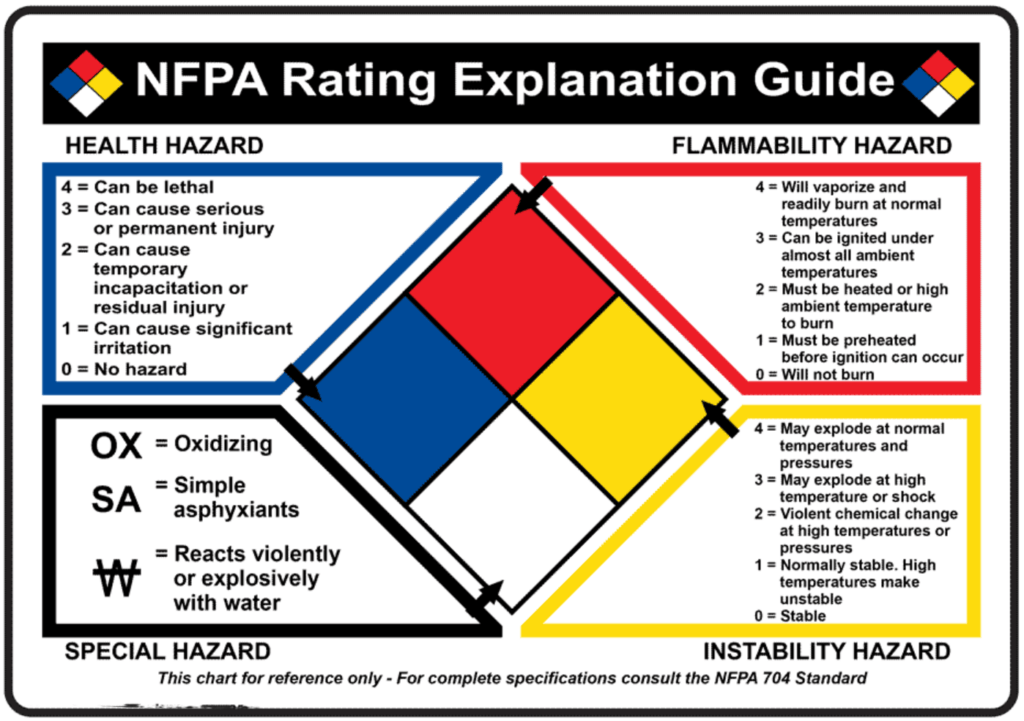
The NFPA Diamond, or NFPA 704, is a standardized labeling system to communicate the hazards associated with chemicals and materials. It is a crucial tool for emergency responders, providing quick and essential information about the potential risks and appropriate handling procedures for hazardous substances. In this blog, we will dive into the meaning of “what is NFPA” and why it is so important.
Read more: 5s Red Tags – The Correct Way To Use A Simple Lean Tool
What Is NFPA Diamond
The NFPA fire diamond meaning is a diamond-shaped sign divided into four quadrants, each representing a different hazard category. These categories include flammability, health hazards, reactivity, and special hazards. The diamond is color-coded, with each color corresponding to a specific hazard.

Look at each colour’s representation breakdown:
- Red: Flammability – Indicates the likelihood of a substance catching fire.
- Blue: Health Hazards – Indicates the potential health risks associated with exposure to the substance.
- Yellow: Reactivity – Indicates the likelihood of a substance reacting explosively.
- White: Special Hazards – Indicates any additional special hazards not covered by the other three quadrants.
Each quadrant has a numerical rating from 0 to 4, with 0 representing no hazard and 4 representing a severe hazard. The combination of color and number quickly assesses the level of danger posed by a particular substance.
Interpreting The NFPA Diamond
To understand the NFPA Diamond meaning fully, knowing the meaning behind the symbols and numbers within each quadrant is essential. Let’s take a closer look at what each symbol and number signifies:
1. Flammability (Red Quadrant)
The red quadrant of the NFPA Diamond indicates the flammability of a substance. The numbers in this quadrant represent the ignition and combustion characteristics of the material.
- 0: Indicates a substance that will not burn.
- 1: Indicates a substance that requires significant heating to ignite.
- 2: Indicates a substance that can ignite under relatively high temperatures.
- 3: Indicates a substance that can ignite at average ambient temperatures.
- 4: Indicates a substance that can readily ignite and burn at average temperatures.
2. Health Hazards (Blue Quadrant)
The blue quadrant of the NFPA Diamond communicates the potential health risks associated with exposure to a substance. The numbers in this quadrant represent the severity of the health hazards.
- 0: Indicates no significant health hazards.
- 1: Indicates a substance that may cause mild irritation or minor injuries.
- 2: Indicates a substance that can cause temporary incapacitation or residual injury with intense or prolonged exposure.
- 3: Indicates a substance that can cause serious temporary or moderate residual injury.
- 4: Indicates a substance that can cause severe injury or death even with brief exposure.
3. Reactivity (Yellow Quadrant)
The NFPA Diamond’s yellow quadrant signifies a substance’s reactivity or explosiveness. The numbers in this quadrant indicate the potential for a violent chemical reaction.
- 0: Indicates a substance that usually is stable and not reactive with water or air.
- 1: Indicates a substance that may become unstable at elevated temperatures or pressures.
- 2: Indicates a substance that can undergo a violent chemical change when exposed to heat or reacts violently with water.
- 3: Indicates a substance that may detonate or undergo explosive decomposition under certain conditions.
- 4: Indicates a substance that can readily undergo explosive decomposition or detonate at normal temperatures and pressures.
4. Special Hazards (White Quadrant)
The white quadrant of the NFPA Diamond is reserved for special hazards that do not fit into the other three categories. It contains symbols that represent specific risks associated with the substance.
Authorized symbols in the white quadrant include:
- OX: Represents substances that are oxidizers and can accelerate the combustion of other materials.
- SA: Indicates simple asphyxiant gases that can displace oxygen and cause suffocation.
- W: Signifies substances that react dangerously with water.
It’s important to note that non-authorised symbols may appear in the white quadrant, such as symbols for corrosive materials (ACID, ALK) or biohazards. The NFPA does not officially recognize these symbols but is still used in some contexts.
Importance Of The Nfpa Diamond
The NFPA Diamond is a vital tool for promoting workplace safety and emergency response situations. Take a look at the reasons why the NFPA Diamond is important:
- Quick Identification of Hazards: The NFPA Diamond allows emergency responders and workers to identify the hazards associated with a substance quickly. This enables them to take appropriate precautions and respond effectively in emergencies.
- Enhanced Communication: Using standardized symbols and color-coding on the NFPA Diamond ensures clear communication of hazards across different languages and cultural backgrounds. It eliminates ambiguity and reduces the potential for misunderstandings.
- Protection of Personnel: The NFPA Diamond helps protect the health and safety of workers by providing essential information about the risks associated with hazardous materials. It allows them to take necessary precautions and use proper personal protective equipment (PPE) when handling or working near these substances.
- Facilitation of Emergency Response: During emergencies such as fires or chemical spills, the NFPA Diamond aids emergency responders in identifying the nature of the hazard and determining the appropriate response strategies. It helps them prioritize actions and minimize the risk to themselves and others.
- Compliance with Regulations: While NFPA 704 labeling is not mandatory, many industries and facilities adhere to it as a best practice. Following NFPA, 704 guidelines ensures compliance with local, state, and federal regulations related to chemical hazard communication.
Organizations must train employees to read and interpret the NFPA Diamond to enhance safety awareness and response capabilities.
Conclusion
The NFPA Diamond, or NFPA 704, is a standardized labeling system that provides essential information about the hazards associated with chemicals and materials. It’s color-coded quadrants and numerical ratings offer a quick and visual assessment of flammability, health hazards, reactivity, and special hazards. Emergency responders and workers can make informed decisions to protect themselves and others by understanding the symbols and numbers within each quadrant. The NFPA Diamond is critical in promoting safety, facilitating effective emergency response, and ensuring compliance with relevant regulations.

